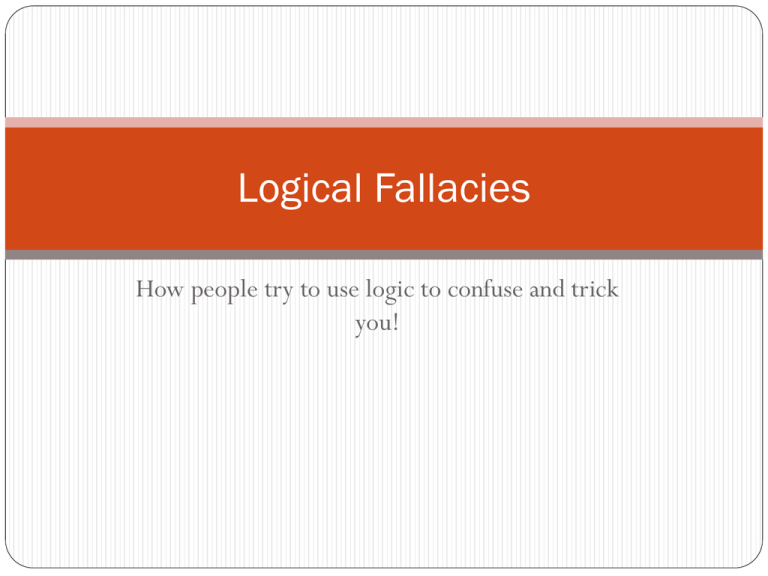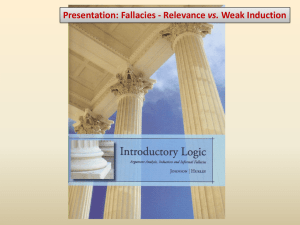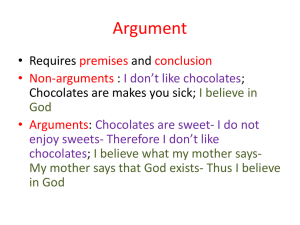
Logical Fallacies
How people try to use logic to confuse and trick
you!
Logical Fallacies are considered propaganda.
Propaganda is the manipulation and control of language.
It transmits more than one message, depending on what the
recipient wishes to hear or is told to hear.
Some required elements for propaganda:
Supporters: The masses must be behind the leader and feel that his
or her new ideas will make a real difference in their lives.
Ignorance of followers: It’s important that the followers and
supporters of the leader not be too educated. They must follow
blindly and without question.
Scapegoat: There must be someone or something to blame for all of
the bad conditions the leader wants to eradicate. Usually, it is the
leadership in current power. Later, any problems which arise can be
blamed on the scapegoat.
COMMON LOGICAL FALLACIES
1. Hasty Generalization: The writer bases the argument on
insufficient or unrepresentative evidence, or an isolated
example.
Example: You have owned two poodles, and they have
both attacked you. If you declare that all poodles are
vicious dogs, you are making a hasty generalization.
Example: “My opponent seems to be an inconsiderate
person.” Does the speaker offer examples or evidence
to support this claim?
2. Non Sequitur (“it doesn’t follow”): The writer’s
conclusion is not necessarily a logical result of the facts.
Example: When you conclude “Tony Hawk is a great
skateboarder, so he will be an excellent skateboard
teacher” this is a non sequitur. Just because someone
knows how to do something well does not
automatically mean that he or she can teach it well.
COMMON LOGICAL FALLACIES
3. Begging the Question (also known as circular reasoning): The
writer presents as truth what is supposed to be proven by the
argument (assumes point is already accepted as a fact) .
Example: In the statement “All useless laws such as Reform
Bill 13 should be repealed,” the writer has already
pronounced the bill useless without assuming responsibility
for proving that it is useless.
4. Red Herring: The writer introduces an irrelevant point to
divert the readers’ attention from the main issue. This term
originates from the old tactic used by escaped prisoners, of
dragging a smoked herring, a strong-smelling fish, across their
trail to confuse tracking dogs by making them follow the
wrong scent.
Example: Roommate A might be criticizing roommate B for
his or her repeated failure to do the dishes when it was his
or her turn. To escape facing the charges, roommate B
brings up times in the past when roommate A failed to repay
some money he or she borrowed. Even though this could be
a problem, it is not relevant to the original argument.
COMMON LOGICAL FALLACIES
5. Argument Ad Hominem (“To the man”): The writer attacks the opponent’s
character rather than the opponent’s argument.
Example: The statement “Dr. Bloom can’t be a competent marriage
counselor because she’s been divorced” may not be valid. Bloom’s
advice to her clients may be excellent regardless of her own marital
status.
Example: calling members of the National Rifle Association “trigger
happy,” drawing attention away from their concerns about the Second
Amendment Rights.
6. Argument Ad Populum (“To the people”): The writer evades the issues by
appealing to reader’s emotional reactions to certain subjects. Instead of
arguing the facts of an issue, the writer might play on the readers’
responses to certain ideas or words. The writer uses words such as
“communism,” “fascism,” or “radical” to get a negative response from a
reader and use words such as “God,” “country,” or “liberty” to get a
positive response from a reader. The idea being to compliment people,
making them feel important , intelligent or good.
Example: “If you are a true American, you will vote against the
referendum on flag burning,” is a statement where the writer avoids
discussion of the merits or weaknesses of the bill and merely substitutes
an emotional appeal.
COMMON LOGICAL FALLACIES
7. Either/or: The writer tries to convince the readers
that there are only two sides to an issue – one right,
one wrong.
Example: The classic 1960’s bumper sticker that was
popular during the debate over the Vietnam War is
an example of this: “America: Love It or Leave It.”
Obviously, there are other choices.
8. Hypostatization: The writer uses an abstract concept
as if it were a concrete reality.
Example: “History has always taught us . . .” or
“Science has proven . . .” or “Research has
discovered . . . .” The implication in each case is that
history or science (or any other discipline) has only
one opinion which is an incorrect assumption.
COMMON LOGICAL FALLACIES
9. Bandwagon Appeal: The writer tries to validate a point by intimating that
“everyone else believes in this.” Such a tactic evades discussion of the issue
itself.
Example: Advertising often uses this technique: “Discriminating women
use Smacky-Mouth lipstick.” A recent Colorado bumper sticker says “Eat
lamb – could 1000’s of coyotes be wrong?”
Example: “Join the rest of the nation in our goal to keep America great,
and vote for me.” Does joining everyone make it a good idea?
10. Card Stacking: This term comes from stacking a deck of cards in your
favor. Card stacking is used to slant a message. Key words or unfavorable
statistics may be omitted in an ad or commercial, leading to a series of
half-truths.
Example: “I introduced more bills into Congress than anyone else.” How
successful were the bills? How many passed? The speaker might leave out
failures.
COMMON LOGICAL FALLACIES
11. Faulty Analogy: The writer uses an extended
comparison as proof of a point. Look closely at all
extended comparisons and metaphors to see if the two
things being compared are really similar. Although a
compelling analogy might suggest similarities, it alone
cannot prove anything.
Example: In a recent editorial a woman bemoaned laws requiring
small children to sit in car seats saying that lawmakers could just
as easily require mothers to breastfeed instead of using formula.
Are the two situations really alike?
12. Quick Fix: The writer leans too heavily on catchy
phrases or empty slogans. A clever turn-of-phrase may
grab one’s attention, but it may lose its persuasiveness
when scrutinized closely.
Example: A banner at a recent rally to protest a piece of antigun
legislation read, “When guns are outlawed, only outlaws will have
guns.” Although the sentence had nice balance, it oversimplified
the issue.
COMMON LOGICAL FALLACIES
13. Faulty Cause / Effect: A cause and effect relationship
that might not be true.
Example: “When I took office, the unemployment rate
dropped to four percent.” Listeners should question whether
the rate dropped because of the person in office or other
factors beyond the person’s control. Did that person actually
cause the rate to drop?
10 propaganda techniques to catch on the
fly…look for these elements in advertisements!
1. Repetition: Repeat, repeat, repeat
2. Nostalgia: Forget the bad parts of
the past; only remember the
good.
3. Beautiful People: Use good-looking
models in ads to suggest that
we’ll look like the models if we
buy the product.
4. Bandwagon: Everybody is doing it!
5. Scientific Evidence: Use the
paraphernalia of science (charts,
graphs, etc.) to “prove”
something.
6. Maybe: Exaggerated or outrageous
claims are commonly preceded
by “maybe,” “might,” or “could.”
7. Symbols: Designs, places, music,
etc. , symbolizing tradition,
nationalism, power, religion, sex,
family, or any concept with
emotional concept.
8. Testimonials: Use famous people to
sell a product (voice-overs).
9. Humor: Make them laugh to
persuade.
10. Name-calling: Direct or Indirect,
audiences love it.
What is the motive behind the appeal?
Why do we fall for the appeal?
1. Self-preservation: desire to survive,
need of food, clothing, shelter,
oxygen, and rest. Security and
safety… free from worries.
2. Pride: feeling of personal worth and
accomplishment. Work hard, build
morale and win approval.
3. Personal Enjoyment: desire for beauty,
comfort, and recreation.
4. Love and Affection: need to give and
receive love, to have friends, close
family ties, to promote common
good.
5. Acquisition and Saving: appeal to the
pocketbook, to a desire for
ownership.
6. Adventure and Curiosity: need for
exploration, reading, watching,
daydreaming.
7. Loyalty: faithfulness to nation
(patriotism), school (school
spirit), city and friends and family.
8. Imitation: need to conform with
dress, hair styles, slang, actions,
motivated by imitation of hero or
movie star.
9. Reverence: desire to “look up” to
someone; hero worship, tradition,
worship or supreme being.
10. Creating: urge to invent, build,
make, plant, paint, organize, etc.
Now It’s Your Turn!
Work with your partner next to you, and…
Create a topic (see examples below)
War
School Lunches
Athletics in school
Religion in government
Develop a stance/claim
Ex. of developing a claim:
School Lunches = Students should be allowed to go off campus for
lunch.
Write a statement for EACH of the 13 logical fallacies for
your claim (yes you must do ALL 13 logical fallacies).
1. Logical Fallacy: When students are allowed to go off campus,
their grades improve.












